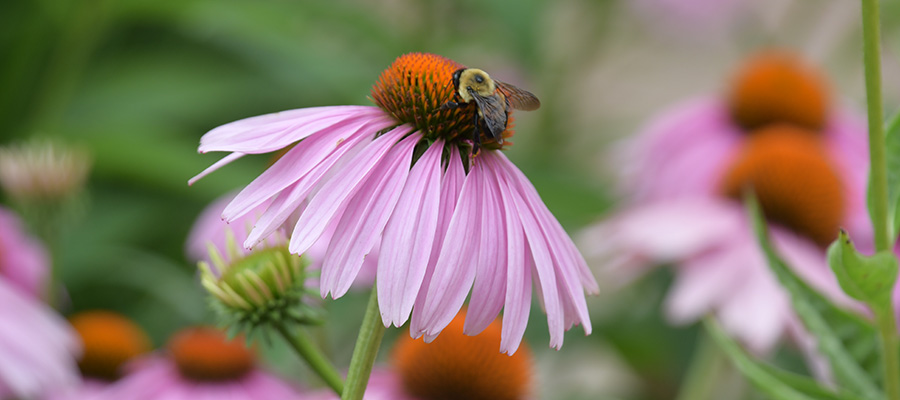A place for pollinators
Valerie Thurston ’22, an environmental biology major, strolls among the native Ohio plants on the solar prairie at Curran Place and takes in a deep breath. Most of the plants are waist high or taller and the aroma is sweet. Thurston smiles as she watches a bee swoop down onto the center of a bright yellow coreopsis.

Before graduating in May, Thurston was the leader of a group of environmental biology student interns working to conserve the bee population on campus and within the Dayton community.
Thanks to their work and collaboration with facilities management and biology faculty and students, UD was named an official Bee Campus by Bee City USA, an initiative of the Xerces Society for Invertebrate Conservation.
The designation recognizes the University for its conservation efforts by providing nest sites for pollinators on campus and reducing its use of pesticides.
“This felt like I was leaving my mark here and that we had accomplished something big for UD.”
Thurston said she is proud of her work to make UD’s campus a thriving place for the bee population through the project that was started last summer. UD received Bee Campus designation news one month before graduation. “This felt like I was leaving my mark here and that we had accomplished something big for UD,” Thurston said.
- Around 3,600 species of bees are native to the United States. There are more than 20,000 species of bees globally.
- “The bees love lemon mint, bee balm, coreopsis, Indian blankets and black-eyed Susans, and the butterflies love milkweed,” Valerie Thurston said.
- Thurston said the biggest factor of the application was the native pollinator plants the University has invested in around campus — more than 80 species in all.
- The project worked closely with the Ohio Pollinator Habitat Initiative, a major partner for the development of UD’s pollinator areas.
- The Marianist Environmental Education Center has worked closely with UD on this project and regularly aids the Dayton community in developing pollinator areas. The Center established and maintains the campus pollinator area at Adèle Center.
- “The campus’s proximity to the Great Miami River makes it an ideal place for butterflies to stop during their migration cycle,” said Leah Ceperley ’17, sustainability planning and evaluation manager at UD.
- Pollinators are a keystone species in essentially every ecosystem on earth, enabling the reproduction of more than 85% of all flowering plants and 67% of agricultural crops.
- In addition to various species of bees, butterflies, moths, beetles, flies, wasps, bats and hummingbirds also contribute to pollination.
- The top five pollinators found on the solar prairie at Curran Place are: sweat bee, bumblebee, carpenter bee, European paper wasp and high noon ant.